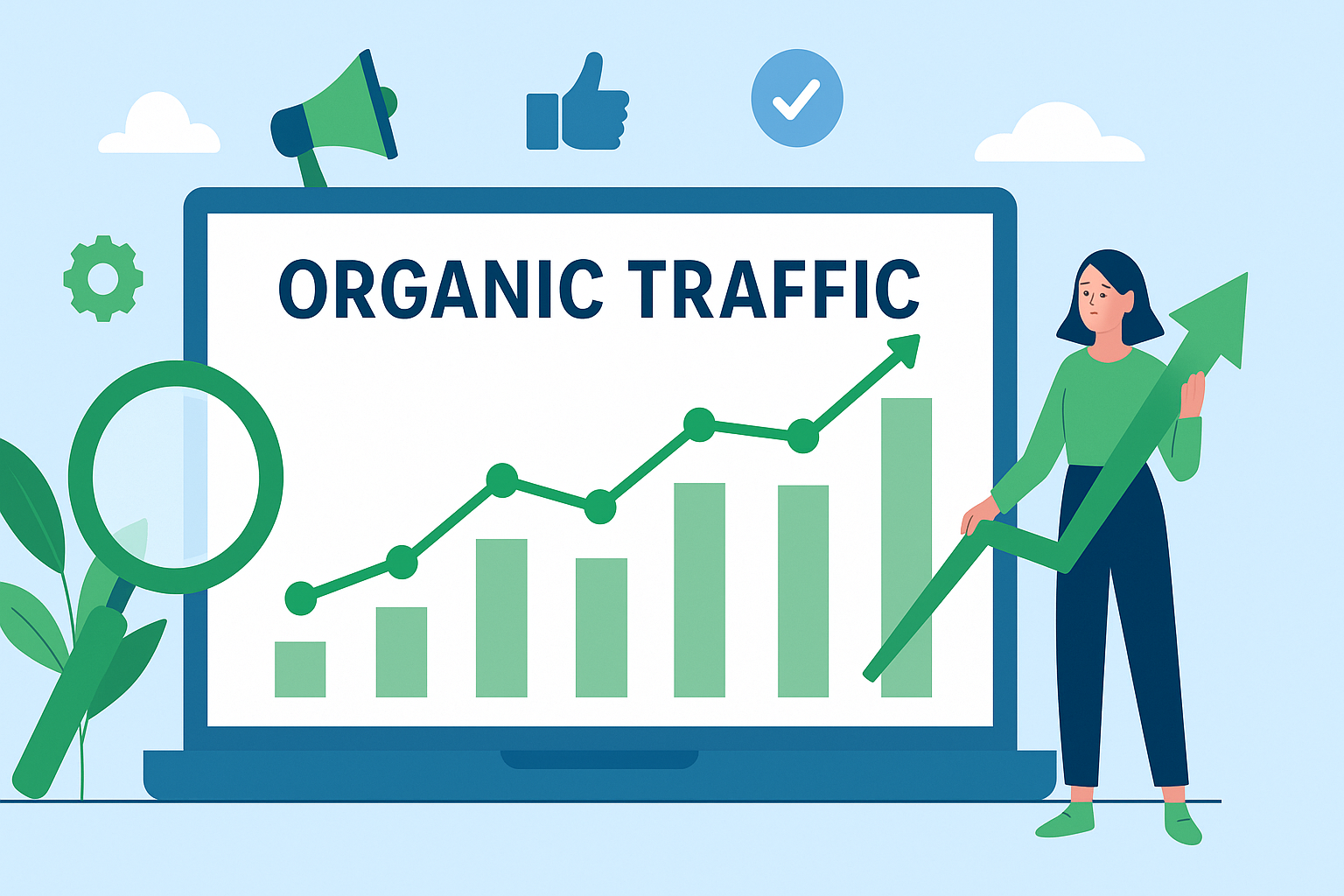Getting organic traffic is one of the most sustainable ways to grow your online presence. But it’s not as easy as it sounds. You might not need a big budget for this but you need a strategic planning to call visitors to your website.
Organic visitors are genuinely interested in your content, products and services. Whether you’re running a blog, an eCommerce site, or a business portfolio – these 21 tips will help you attract visitors without relying on paid ads.
1. Master Keyword Research
Before writing any content, research the exact terms your audience is searching for. Use tools like Google Keyword Planner, Ubersuggest, or Ahrefs to find keywords with a balance of search volume and low competition. Focus on long-tail keywords which are more specific and often less competitive. Don’t just stuff them in your post—create high-value content that naturally includes these keywords. This helps search engines understand the topic of your content while also addressing real user queries.
Go deeper by analyzing keyword intent. Are people looking for information, trying to buy something, or just browsing? Match your content to their intent to increase relevance and improve ranking potential. Also, consider looking at “People Also Ask” on Google and related search terms to build a content map around the keyword.
2. Write High-Quality, In-Depth Content
Search engines love content that thoroughly answers a user’s question. Instead of writing short posts, aim for comprehensive guides that cover a topic fully. Break your content into clear sections with headers, include examples, visuals, and actionable insights. In-depth content tends to rank better, stay relevant longer, and earn more backlinks over time.
Quality doesn’t mean long for the sake of length. It means content that’s well-researched, informative, original, and offers a great user experience. Use facts, stats, quotes, and multimedia elements to enrich your posts. Also, regularly update older content to keep it fresh and competitive in the SERPs.
3. Optimize On-Page SEO
Ensure your titles, headers, URLs, and meta descriptions are optimized for both users and search engines. Use your focus keyword in strategic places like H1, H2, the first 100 words, and image alt texts. Also, make URLs short and descriptive.
Use schema markup to help search engines better understand your content. Tools like Rank Math or Yoast SEO can make optimization easy for WordPress users. Don’t forget internal linking to guide users and distribute link equity, and make sure your content is easy to scan with bullet points, bold text, and short paragraphs.
4. Improve Page Speed
A slow-loading website drives visitors away. Google also uses page speed as a ranking factor. Use tools like Google PageSpeed Insights or GTmetrix to test your site speed. Compress images, enable browser caching, minify CSS/JS, and use a CDN to improve performance.
Even a one-second delay can reduce conversions and increase bounce rates. Opt for lightweight themes, limit plugins, and use lazy loading for media. Mobile speed is especially critical as more users browse on smartphones. Hosting plays a big role, so invest in a reliable provider.
5. Make Your Site Mobile-Friendly
More than half of web traffic comes from mobile devices. A mobile-friendly design ensures your content looks and functions well on all screen sizes. Use responsive themes, readable fonts, and tap-friendly buttons.
Google prioritizes mobile-first indexing, meaning your mobile version is used for ranking. Test your site on different devices and use Google’s Mobile-Friendly Test tool. If your layout, forms, or popups aren’t usable on mobile, you risk losing a significant audience segment.
6. Create a Content Calendar
Consistency is key to building organic traffic. A content calendar helps you plan topics, publishing dates, and promotions. It keeps your content strategy focused and ensures regular posting.
Brainstorm monthly themes, keyword-focused blog posts, seasonal topics, and pillar content. Include time for content updates and repurposing. Use tools like Trello, Notion, or Google Sheets to stay organized. Regular content builds topical authority and gives search engines more pages to rank.
7. Start a Blog
Blogging is one of the most effective ways to attract organic visitors. Every post gives you a chance to rank for new keywords. Share tutorials, how-tos, listicles, reviews, and thought leadership pieces.
Focus on evergreen topics that bring in long-term traffic, and sprinkle in trend-based posts for short bursts. Make sure your blog aligns with your audience’s interests and solves real problems. Encourage discussion in the comments and promote each post through multiple channels.
8. Use Internal Linking
Internal links guide users to related content and help search engines crawl your site. Link to older posts, relevant services, or deeper explanations to increase time on site and reduce bounce rate.
Use descriptive anchor text that signals what the user can expect. Create a site structure where cornerstone content links out to related blog posts and vice versa. A strong internal linking system builds topical authority and improves SEO.
9. Promote on Social Media
Don’t wait for search engines to discover your content. Share your posts on Instagram, Facebook, LinkedIn, Pinterest, Twitter/X, and Threads. Create platform-specific captions and use relevant hashtags.
Engage with followers by responding to comments and resharing UGC. Join relevant communities or groups where your audience hangs out. Use social sharing buttons on your blog posts to encourage visitors to spread the word. More shares mean more traffic and backlinks.
10. Focus on Backlink Building
Backlinks from trusted sites signal authority and improve rankings. Reach out to bloggers, journalists, and creators in your niche. Offer to write guest posts, submit your site to directories, or collaborate on round-up posts.
Use tools like Ahrefs or SEMrush to analyze competitors’ backlink profiles and uncover opportunities. Broken link building and expert quotes are effective tactics. Earning backlinks takes time, but it pays off in higher visibility and trust.
11. Leverage Email Marketing
Email isn’t just for sales — it’s powerful for bringing readers back to your website. Build an email list with lead magnets (checklists, eBooks, etc.). Then send newsletters, blog updates, or personalized tips.
Segment your list for better targeting and use tools like MailerLite, ConvertKit, or Mailchimp. Add opt-in forms throughout your website, including in your blog posts and popups. When you publish a new post, send it to your subscribers to generate instant traffic.
12. Use Video Content
Videos increase engagement and dwell time, which indirectly helps SEO. Create YouTube videos around your blog topics and embed them in your articles. Also share short-form videos on Instagram Reels, YouTube Shorts, or TikTok.
Explain complex topics visually or show step-by-step tutorials. Don’t forget to optimize titles and descriptions with keywords. Add CTAs to visit your site or blog for more info. Videos make your brand more memorable and can bring in a whole new audience.
13. Update Old Content
Instead of constantly creating new content, revisit and update older posts. Refresh outdated stats, improve readability, add new sections, and optimize for current keywords.
Use Google Search Console to find posts that rank on page 2 or 3 and give them a boost. Updated content can regain rankings, increase CTR, and improve engagement. Also update the publish date to signal freshness to search engines.
14. Add Schema Markup
Schema helps search engines understand your content better. You can use it to show reviews, FAQs, ratings, how-tos, and events directly in the search results as rich snippets.
Tools like Schema Pro or Rank Math make it easy to implement on WordPress. Structured data can increase your click-through rate by making your listings more visually appealing and informative.
15. Create Link-Worthy Resources
Create high-value assets like statistics pages, original research, downloadable templates, or detailed guides. These are more likely to attract backlinks.
Think about what people in your niche would want to reference or bookmark. Promote these assets through outreach and on platforms like Reddit or Quora. Link-worthy content gives you more credibility and exposure.
16. Encourage User-Generated Content (UGC)
UGC builds trust and keeps your content dynamic. Ask your users for testimonials, reviews, photos using your products, or stories. Feature them on your blog or homepage.
It boosts engagement and creates social proof. Encourage submissions through contests or shoutouts. Google also values fresh, authentic content from users.
17. Use Forums and Q&A Sites
Answer questions on Quora, Reddit, Stack Exchange, and niche forums. Link back to your blog posts if relevant. This builds authority and drives targeted traffic.
Be helpful and don’t spam. Focus on solving real problems. Over time, these answers rank in Google and send steady visitors your way.
18. Add a FAQ Section
FAQs help you rank for question-based searches. They also improve user experience by addressing common doubts.
Use real questions from your audience, Google’s “People Also Ask,” or tools like AlsoAsked. Structure your answers clearly and keep them concise. Adding FAQ schema also helps with rich snippets.
19. Collaborate With Influencers
Partner with influencers in your niche for blog interviews, guest posts, or social shoutouts. Their audience becomes your audience.
It builds credibility and can send high-quality traffic. Focus on micro-influencers for better engagement. Make the collaboration win-win and track results.
20. Focus on E-A-T (Expertise, Authoritativeness, Trustworthiness)
Google prioritizes content from real experts. Showcase your experience, cite credible sources, and include author bios.
Build trust with an About page, HTTPS, contact info, and clear privacy policies. Also earn reviews and mentions on reputable sites. The more Google sees you as an authority, the better your content will rank.
21. Track, Analyze & Improve
Use Google Analytics and Search Console to monitor traffic, bounce rates, and keyword rankings. Find out what works and double down.
Identify pages with high impressions but low CTRs — optimize titles and descriptions. Use heatmaps like Hotjar to improve user experience. SEO isn’t a one-time job. It’s about testing, learning, and improving constantly.
Final Thoughts
Driving organic traffic takes time, but it’s absolutely worth it. Every tip here builds on the others to create a solid SEO foundation. Start small, stay consistent, and remember: high-value content + strategic SEO = long-term success.









